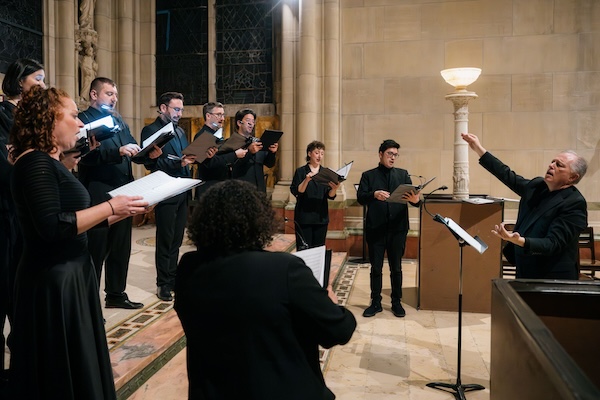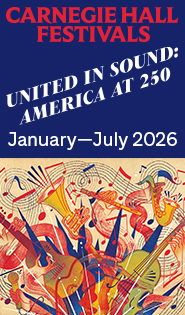Musica Sacra refreshes the spirit with an intimate, immersive program
If you’ve ever wondered what it feels like to be inside a piece of music, Musica Sacra’s SurRound concert offered an answer.
On Tuesday evening, the ensemble’s latest immersive choral program drew listeners into an embodied acoustic experience, fully activating the Cathedral of St. John the Divine as a resonant instrument.
Under the direction of Kent Tritle, twenty singers performed a cappella works spanning nearly a millennium, from Gregorian chant and Pérotin’s 12th-century polyphony to traditional spirituals and contemporary compositions by Sarah MacDonald and Joanna Forbes L’Estrange.
The program unfolded as an exploration of how sound travels, disperses, lingers, and ultimately envelops. Each piece featured a different configuration of singers, creatively positioned above the choir stalls, behind the nave, or encircling the audience. This was a contemplative experience well-suited to the liturgical season of Lent, a time marked by slow transitions and the gradual passage from darkness into light, winter into spring.
The performance began with Allegri’s Miserere mei, Deus, projected from three distant points across the cathedral. Rather than drawing the listener toward a central sound source, this arrangement displaced the center entirely; the audience, seated in the Crossing, became the center as the music echoed from the far reaches of the nave. There was an almost involuntary urge to locate the performers as sound emerged from behind, then from the front and left. Soprano Rachel Doehring Jackson performed the iconic high C with expressive tone and color; her final “cry” was more human and celestial—personal, plaintive, and immediate.
After this opening, the Gregorian chant Da pacem, Domine served as a mindful transitional moment. The singers proceeded up the central aisle and reassembled in a traditional front-facing orientation for Adolphus Hailstork’s setting of “Motherless Child.” Baritone Oliver Holt’s solo brought gentle gravity and warmth to the spiritual. The choir complemented his rounded tone and soprano Kathryn McCreary’s floating line with attentive phrasing and a nuanced dynamic palette. The choir’s accompanimental “m’s” in “sometimes” felt soft and almost maternal.
John Tavener’s Lament of the Mother of God was infused with grief and modal austerity. Mezzo-soprano Helen Karloski stood apart from the ensemble in the upper choir stalls, conveying Mary’s solitude with great pathos. The physical separation of the soloist, combined with the haunting way her voice blended in and out of the choir, reinforced the work’s sense of spiritual isolation.
A highlight of the program was Sarah MacDonald’s Crux Fidelis, set to the Latin refrain “faithful cross,” interspersed with poems by Emily Dickinson and Emilia Lanier. The choir here was divided evenly above the audience on either side of the choir stalls. Enhancing the drama, the conductor faced forward towards the audience. This cruciform layout placed listeners at the intersection of the voices, allowing each texture and line to emerge with perfect, balanced clarity. Anchored by a chant-like ostinato on “Crux fidelis,” the piece circled around the listener, grounding its dissonances in something enduring.
The men’s voices, still positioned above the audience, performed William Dawson’s spiritual “Soon I Will Be Done,” followed by treble voices in Joanna Forbes L’Estrange’s gospel-inflected “Give Us Grace.” Syncopated rhythms introduced warmth and ease, while shimmering dissonances were tuned with precision. It was a moment of tonal softening and an emotional turning towards quiet hope.
Lauridsen’s O nata lux brought the program to its most immersive point. Led by Tritle from the center of the main aisle, with singers dispersed throughout the sides, this intimacy heightened the luminosity of the harmonies, which resonated not as distant radiance but as something near and tactile. Rather than watching a performance, it felt as if one was held within it.
Throughout the program, the organic movement of the choir invited the audience to listen in new ways. Each piece activated a different relationship to space—not only to the music itself, but to where and how it arrived and receded. The experience transformed the grandeur of the cathedral into something unexpectedly intimate and deeply felt.
Musica Sacra presents a “Songs and Romances” fundraiser 6 p.m. May 13. musicasacrany.com



